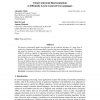1750 search results - page 46 / 350 » Formal multiple-bernoulli models for language modeling |
102
click to vote
JMLR
2010
14 years 4 months ago
2010
We present a polynomial update time algorithm for the inductive inference of a large class of context-free languages using the paradigm of positive data and a membership oracle. W...
ICFEM
2007
Springer
15 years 3 months ago
2007
Springer
We present a formal, tool-supported approach to the design and maintenance of access control policies expressed in the eXtensible Access Control Markup Language (XACML). Our aim is...
ENTCS
2002
14 years 9 months ago
2002
PLAN is a language designed for programming active networks, and can more generally be regarded as a model of mobile computation. PLAN generalizes the paradigm of imperative funct...
SAC
2011
ACM
14 years 17 days ago
2011
ACM
Spatial networks like transportation, power, and pipeline networks are a ubiquitous spatial concept in everyday life and play an important role for navigational and routing purpos...
SOSYM
2010
14 years 4 months ago
2010
Component-based software engineering (CBSE) is viewed as an opportunity to deal with the increasing complexity of modern-day software. Along with CBSE comes the notion of component...

